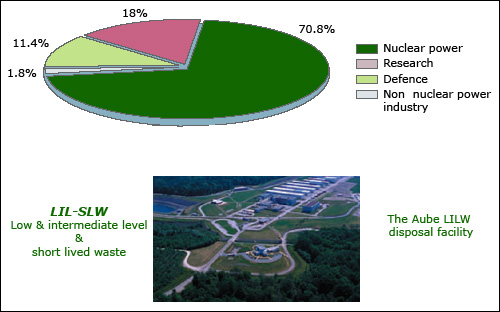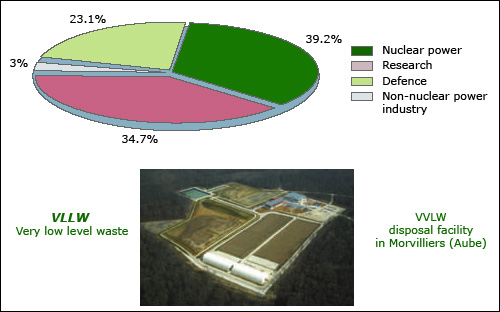An overview of French waste categories (continued)…

Low and intermediate level short-lived waste (LILW-SL)
There was 830,000 m3 of this low to intermediate-level short-lived waste in France according to the inventory drawn up by ANDRA at the end of 2010. Most of it was already in surface disposal facilities. As its name implies, the initial level of activity is from low to intermediate. Because of the rapid decay of the short-lived radioactive atoms, its radioactivity diminishes enough over a few decades for the radiological risk to be considered low.
© ANDRA
Low- and intermediate-level short-lived waste (LILW-SL): This waste accounts for 0.07% of the total radioactivity and 79.6% of the volume of the national inventory. Since 1992, this waste has been disposed of in vast concrete repository structures at the Andra waste disposal facility in Aube. The Aube facility, known as CSA is taking over from the Manche waste disposal facility, which received over 500,000 m³ between 1969 and 1994. It has a total capacity of one million cubic metres and should be full in fifty years’ time at the current rate.

Very low-level waste (VLLW)
There was 360,000 m3 of this very low-level waste in France according to the inventory prepared by ANDRA at the end of 2010. For VLLW there is no need to distinguish between short-lived and long-lived radioelements, because of their very low radioactivity. That is why this waste is already disposed of on an industrial scale.
© ANDRA
Very low-level waste (VLLW): VLLW represents a very small part of the total radioactivity but 11.1% of the volume of the national inventory (360,000 m³ accumulated at the end of 2010). For the most part it is produced on the sites of nuclear facilities. This type of waste (metal containers, large sacks of rubble, metal drums, large metal parts, etc.) is disposed of on the surface.
After processing (e.g. compacting) it is placed in cells dug into the clay at the Morvilliers facility run by Andra since 2003, now known as CIRES (Cires waste collection, storage and disposal facility). With a capacity of 650,000 m³, this disposal facility should have been able to accept waste for thirty years, but it filled up sooner than expected and its capacity will have to be increased.

Low-level long-lived waste (LLW-LL)
There was 87,000 m3 of this low-level long-lived waste in France according to the ANDRA inventory at the end of 2010. This total included radium-bearing waste and graphite waste already been taken out of dismantled graphite-moderated gas-cooled reactors, the rest of which will be counted in future inventories. This waste is awaiting a final management solution from Andra’s research teams. Andra has recommended disposal in a clay layer fifteen meters below ground level. No decision has been made on the site of this facility to date.
© ANDRA
Low-level long-lived waste (LLW-LL): The waste in this fifth category is awaiting a final management solution from ANDRA’s research teams. No decision has been made on the siting of this facility to date. It accounts for 0.01% of the total radioactivity and 4.5% of the volume of the national inventory. It includes radium-bearing waste and some of the graphite waste taken out of dismantled legacy graphite-moderated gas-cooled reactors, the rest of which will be counted in future inventories.
Lastly, very low-level mining waste the residue from processing ore, is counted separately. It is stored on uranium mining sites. It represents around 50 million tonnes.
PREVIOUS : France: panorama of waste (1)
Other articles on the subject « Waste Inventory »
Recoverable materials
Inventory of reusable uranium and plutonium stocks The radioactive species present in the spent f[...]
France: waste panorama (1)
An overview of French waste categories… In France, radioactive waste is split into five cat[...]
US panorama
The case of the greatest nuclear power Nuclear-powered US Navy vessels, past production of nuclea[...]
Various radioactive waste
Radioactive waste from many different sources… When radioactive waste is mentioned, people [...]
Mining residues
Waste from uranium extraction The residues from processing uranium ores are disposed of on the si[...]
Medicine and research
Radioactive sources, producers of waste outside the nuclear industry… Biology labora[...]
Military waste
A separate system Using the gaseous diffusion process, the AREVA Pierrelatte facility produced en[...]
Radium-bearing waste
Legacy waste – weakly radioactive but long-lived Recent and less recent industrial activities hav[...]
Waste from Dismantling
Dismantling of facilities: graphite waste Experience with dismantling nuclear power plants is onl[...]
Waste from Industry
Obsolete radioactive sources, the legacy of radium applications There are numerous industrial app[...]